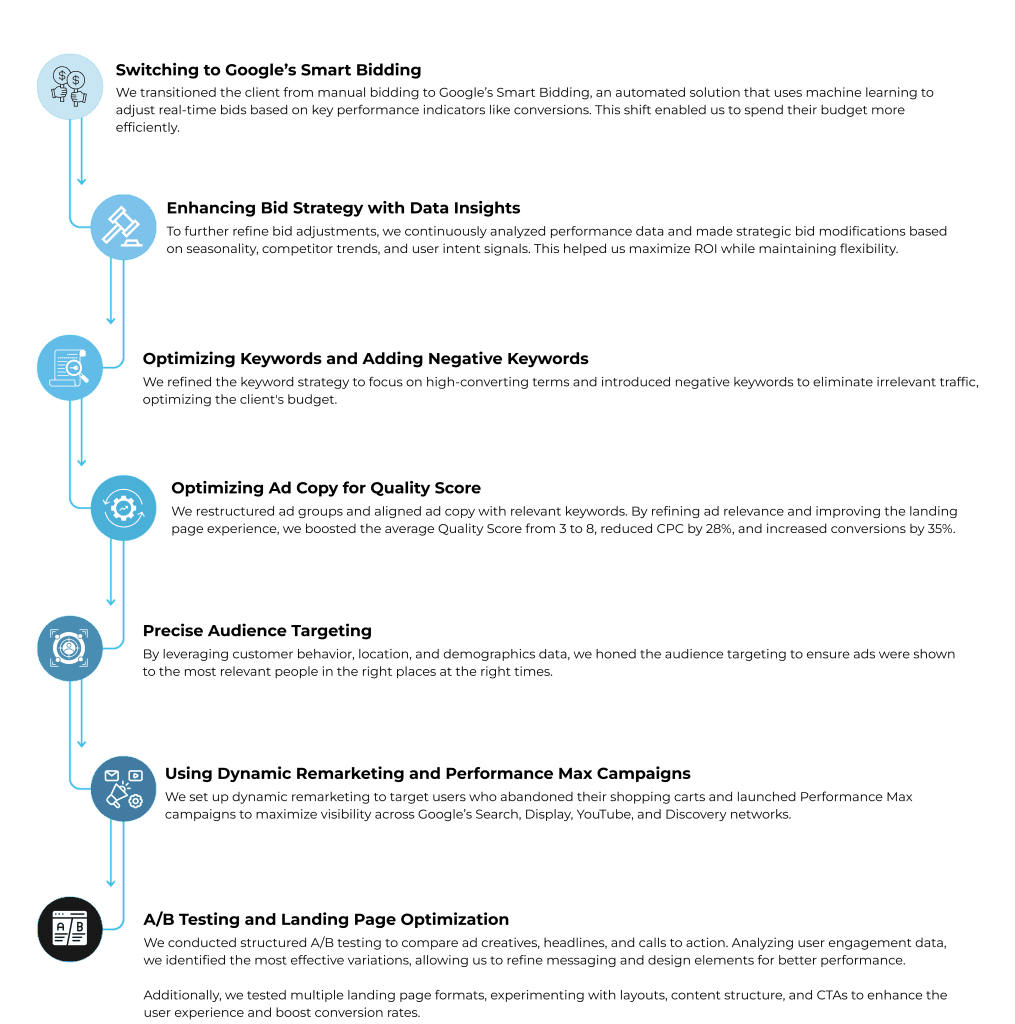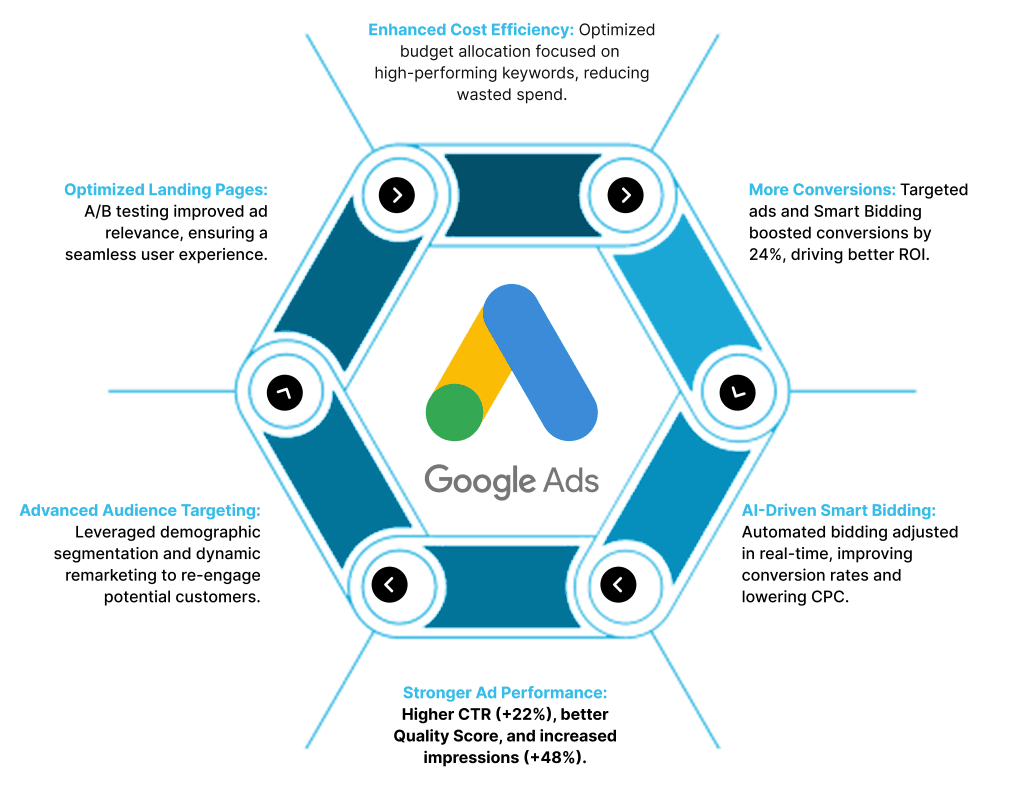Google Ads Bidding Strategy: How Arissa Improved Higher Conversions and Cost Efficiency
Vinay Venkatesh
Running successful online ads is challenging, especially when large budgets are spent but expected results are not achieved. This was the case for our F&B (Food and Beverages) client, who faced high costs while running the Google ads and low conversions. Their existing Google Ads bidding strategy drained their budget with minimal return on investment (ROI).
In this case study, we walk through the challenges faced by the client and how we optimized their bidding strategy to deliver more conversions at a lower cost, leading to more efficient ad spend.
The Challenges with the Client's Google Ads Bidding Strategy
Our client, a well-established brand, faced several key challenges with their Google Ads campaigns:


High Cost-Per-Click (CPC) and Low Conversion Rate
The client’s ads were costing too much, but conversions weren’t coming in. Their budget was drained without delivering the desired results.

Inefficient Ad Spend
Despite investing significantly in Google Ads, there was no clear strategy to optimize their budget. Ads were underperforming, leading to inefficient spending and missed opportunities for better results.

Manual Bidding Struggles
The client was using manual bidding, which lacked data-driven optimization. Bids weren’t adjusted based on performance metrics, leading to missed opportunities and unnecessary costs.
Our Approach to Optimizing the Google Ads Bidding Strategy
To address these issues, we implemented a more strategic and data-driven approach. Here’s how we revamped the client’s Google Ads strategy:

-
Switching to Google’s Smart Bidding
We transitioned the client from manual bidding to Google’s Smart Bidding, an automated solution that uses machine learning to adjust real-time bids based on key performance indicators like conversions. This shift enabled us to spend their budget more efficiently. -
Enhancing Bid Strategy with Data Insights
To further refine bid adjustments, we continuously analyzed performance data and made strategic bid modifications based on seasonality, competitor trends, and user intent signals. This helped us maximize ROI while maintaining flexibility. -
Optimizing Keywords and Adding Negative Keywords
We refined the keyword strategy to focus on high-converting terms and introduced negative keywords to eliminate irrelevant traffic, optimizing the client's budget. -
Optimizing Ad Copy for Quality Score
We restructured ad groups and aligned ad copy with relevant keywords. By refining ad relevance and improving the landing page experience, we boosted the average Quality Score from 3 to 8, reduced CPC by 28%, and increased conversions by 35%. -
Precise Audience Targeting
By leveraging customer behavior, location, and demographics data, we honed the audience targeting to ensure ads were shown to the most relevant people in the right places at the right times. -
Using Dynamic Remarketing and Performance Max Campaigns
We set up dynamic remarketing to target users who abandoned their shopping carts and launched Performance Max campaigns to maximize visibility across Google’s Search, Display, YouTube, and Discovery networks. -
A/B Testing and Landing Page Optimization
We conducted structured A/B testing to compare ad creatives, headlines, and calls to action. Analyzing user engagement data, we identified the most effective variations, allowing us to refine messaging and design elements for better performance.
Additionally, we tested multiple landing page formats, experimenting with layouts, content structure, and CTAs to enhance the user experience and boost conversion rates.
The Impact of Optimizing the Bidding Strategy: A Before-and-After Comparison
To evaluate the effectiveness of the new bidding strategy, let’s take a closer look at the key performance metrics before and after its implementation.
The results clearly demonstrate the positive impact of the optimization efforts on the client’s Google Ads campaign.
Before Implementing the Bidding Strategy

- Impressions: 830K – Limited reach due to inefficient ad placements.
- Clicks 93.1K – Engagement was moderate but not optimized.
- Conversions: 10.3k – High CPC and inefficient targeting led to lower conversions.
- Cost per Conversion: $22.10 – Campaign inefficiency resulted in a higher cost per conversion.
- Total Ad Spend: $228K – The budget was not being utilized effectively.
After Implementing the Bidding Strategy

- Impressions: Increased by 48% (1.23M) – Expanded ad visibility and better targeting improved reach.
- Clicks: Grew by 6% (99K) – More relevant ads led to an increase in user engagement.
- Conversions: Increased by 24% (12.8K) – Better ad relevance and Smart Bidding resulted in more conversions.
- Cost per Conversion: Reduced by 8% ($20.27) – Improved efficiency lowered the cost per conversion, maximizing ROI.

Client Testimonial
“We are pleased to announce that Arissa International has significantly enhanced our advertising strategy. Our Google Ads have become more cost-effective, increasing conversions and providing a substantial return on investment. Their innovative bidding methodology has made a notable impact, and we look forward to continuing our collaborative journey towards growth.”

A Customized Google Ads Bidding Strategy Makes a Big Difference
This case study demonstrates how a well-executed Google Ads Bidding Strategy can transform campaign performance and cost efficiency.
By moving from manual bidding to Smart Bidding, optimizing keywords, and leveraging dynamic remarketing, we delivered impressive results for the client within their existing budget.
The results—lower costs, more conversions, and improved ROI—highlight that Google Ads can be a powerful and cost-effective marketing channel with the right strategy.
